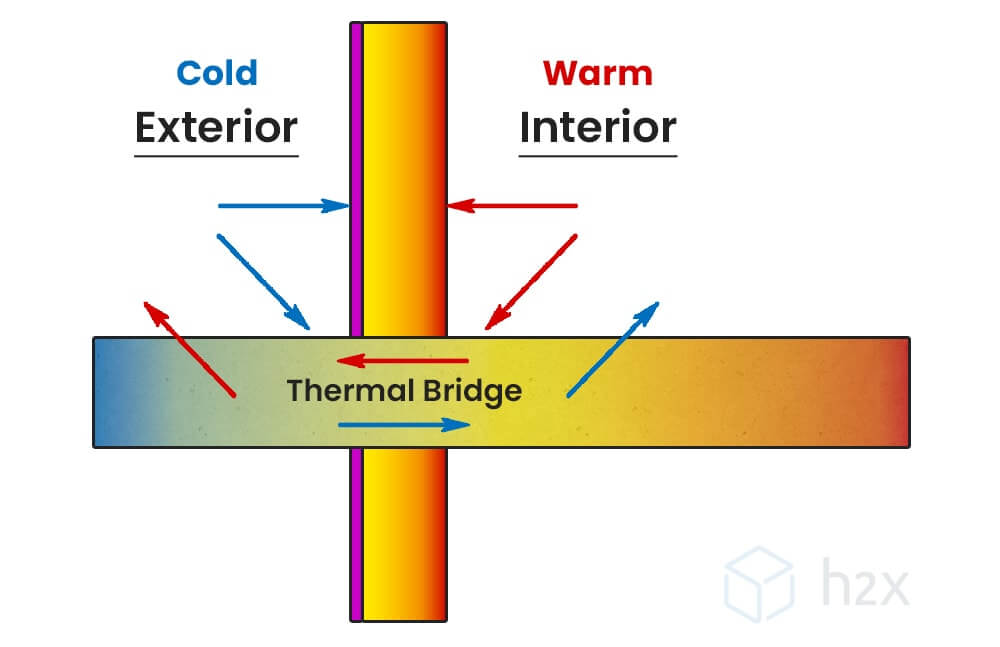External wall insulation does significantly reduce heating costs by minimizing heat loss through a property’s walls.
Since uninsulated solid walls account for up to 35% of heat loss in older homes, adding an external layer of insulation helps retain warmth during winter and keep interiors cooler in summer.
This improved thermal efficiency reduces the need for heating, leading to lower energy consumption and savings on heating bills. According to the Energy Saving Trust, homeowners can save up to £500 per year depending on their home type, location, and existing heating system efficiency.
This article explores the impact of EWI on energy consumption and potential savings.
How Does External Wall Insulation Reduce Heat Loss?
Explaining Heat Loss in Homes
Many UK homes, particularly those built before the 1920s, have solid walls that allow up to 35% of heat loss. Uninsulated external walls contribute significantly to energy inefficiency by letting warm air escape during winter and allowing excessive heat to enter in summer.
A key concept in heat retention is thermal bridging, which occurs when heat travels through building materials that are poor insulators. EWI helps mitigate this by forming a continuous insulating layer over the external walls, reducing thermal bridging and energy waste.
If you need more clarity on if EWI is right for your home contact professional external wall insulation companies in your local area.

How EWI Improves Thermal Efficiency
EWI significantly reduces U-values (a measure of heat loss in building materials). Lower U-values mean better insulation and less heat escaping from your home. Studies have shown that well-installed EWI can reduce U-values from 2.0 W/m²K (uninsulated solid walls) to as low as 0.3 W/m²K, dramatically improving thermal efficiency.
Energy Saving Potential
Homeowners who install EWI can see a significant reduction in heating costs. According to the Energy Saving Trust, insulating solid walls can save up to £500 per year on heating bills, depending on home type and energy usage.
How Much Can You Save on Heating Bills?
In this section, we provide a detailed breakdown of the costs associated with external wall insulation. We’ll explore the factors that influence estimated savings. This will give you a clearer understanding of what to expect when considering external wall insulation.
Average Savings Based on Home Type
| Home Type | Annual Heating Cost (Before EWI) | Annual Heating Cost (After EWI) | Estimated Savings |
|---|---|---|---|
| Detached | £1,500 | £1,000 | £500 (33%) |
| Semi-Detached | £1,200 | £850 | £350 (29%) |
| Mid-Terrace | £1,000 | £750 | £250 (25%) |
| Bungalow | £1,100 | £800 | £300 (27%) |
Breakdown of Savings Factors
- Climate & Location – Homes in colder regions save more due to higher heating needs.
- Property Age & Wall Type – Older properties with solid walls benefit the most from EWI.
- Heating System Efficiency – EWI savings are maximized when combined with an efficient heating system.
ROI (Return on Investment) Calculation
- The cost of EWI installation typically ranges between £8,000 – £15,000.
- With annual savings of £300 – £500, homeowners can recover costs in 16 – 25 years.
- Government grants can significantly reduce this payback period.
Factors That Impact Heating Bill Savings with EWI
Insulation Thickness & Material Type
Various materials are used in the application process of external wall insulation, all of which enhance energy efficiency.
- Thicker insulation (100mm+) provides better energy savings but increases upfront costs.
- Material comparison:
- Mineral Wool: Good for breathability, fire resistance.
- Polystyrene: Higher thermal efficiency, lower cost.
- PIR Boards: Best insulation value but more expensive.
Ventilation & Moisture Control
Proper ventilation prevents damp issues and ensures insulation efficiency. EWI must be paired with effective moisture control measures, such as breathable render systems.
Complementary Energy-Saving Measures
Pairing EWI with double glazing, loft insulation, and airtightness improvements enhances savings.
How EWI Performs in Winter vs. Summer
Winter Benefits:
- Reduces heat loss, keeping the home warmer for longer.
- Reduces boiler usage, lowering gas and electricity bills.
Summer Benefits:
- Blocks excessive solar heat gain, keeping interiors cooler.
- Improves indoor comfort without reliance on air conditioning.
Does EWI Work for All Homes?
Best Home Types for EWI Installation
- Older solid-wall properties (Victorian, pre-1920s) benefit the most.
- Homes with exposed walls or high heat loss areas.
Limitations & Considerations
- Homes with cavity wall insulation already installed may see diminished savings.
- Planning permission may be required in conservation areas.
Grants & Financial Help for EWI Installation
Eligibility depends on factors such as your property type, income level, and whether you receive certain government benefits.
These grants can significantly offset installation costs, helping you improve energy efficiency and lower heating bills.
It’s worth checking with local authorities or energy-saving schemes to see if you qualify for EWI grants.
Government Schemes Covering EWI Costs
- ECO4 Scheme (for low-income households)
- The Great British Insulation Scheme (partial funding)
- Local council-specific funding programs
How to Apply for Financial Assistance
- Check eligibility via the government website.
- Apply through approved EWI installers.
Final Verdict: Does EWI Really Save Money?
Key Takeaways:
- EWI reduces heating costs, but savings depend on home type, insulation thickness, and heating system.
- Older homes with solid walls benefit the most.
- Grants and funding options can shorten the payback period.
By installing external wall insulation, UK homeowners can enjoy a warmer, more energy-efficient home while saving on heating bills over time.

